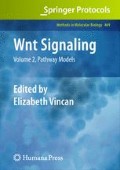Abstract
The Wnt pathway is a highly conserved signal transduction pathway that plays many critical roles in early animal development. Recent studies have shown that this pathway plays a conserved role in the specification and patterning of the animal – vegetal (A – V) axis in sea urchins and sea anemones. These observations have suggested that the common ancestor to cnidarians and bilaterians used the Wnt signaling pathway for specifying and patterning this maternally established axis. Because the A – V axis plays a critical role in germ layer segregation, a better understanding of how the Wnt pathway is regulated along the A – V axis will provide key insight into the molecular mechanisms regulating germ layer segregation and germ layer evolution in animal embryos. Here, we provide a detailed protocol for using mRNA microinjection that can be used to analyze Wnt signaling in early sea urchin embryos. This protocol can also be adapted to introduce morpholino anti-sense oligonucleotides into sea urchin embryos.
Access this chapter
Tax calculation will be finalised at checkout
Purchases are for personal use only
References
Emily-Fenouil, F., Ghiglione, C., Lhomond, G., et al. (1998) GSK3beta/shaggy mediates patterning along the animal-vegetal axis of the sea urchin embryo. Development 13, 2489–2498.
Wikramanayake, A. H., Huang, L., Klein, W. H. (1998) beta-catenin is essential for patterning the maternally specified animal-vegetal axis in the sea urchin embryo. Proc Natl Acad Sci USA 16, 9343–9348.
Angerer, L. M., Angerer, R. C. (2000) Animal-vegetal axis patterning mechanisms in the early sea urchin embryo. Dev Biol 1, 1–12.
Croce, J. C., McClay, D. R. (2006) The canonical Wnt pathway in embryonic axis polarity. Semin Cell Dev Biol 2, 168–174.
Logan, C. Y., Miller, J. R., Ferkowicz, M. J., et al. (1999) Nuclear beta-catenin is required to specify vegetal cell fates in the sea urchin embryo. Development 2, 345–357.
Yaguchi, S., Yaguchi, J., Burke, R. D. (2006) Specification of ectoderm restricts the size of the animal plate and patterns neurogene-sis in sea urchin embryos. Development 133, 2337–2346.
Kumburegama, S., Wikramanayake, A. H. (2007) Specification and patterning of the animal-vegetal axis in sea urchins by the canonical Wnt signaling pathway. Signal Transduction 7, 164–173.
Lee, P. N., Kumburegama, S., Marlow, H. Q., et al. (2007) Asymmetric developmental potential along the animal-vegetal axis in the anthozoan cnidarian, Nematostella vect-ensis, is mediated by Dishevelled. Dev Biol doi:10.1016/j.ydbio.2007.05.040.
Howard, E. W., Newman, L. A., Oleksyn, D. W., et al. (2001) SpKrl: a direct target of beta catenin regulation required for endo-derm differentiation in sea urchin embryos. Development 3, 365–375.
Wikramanayake, A. H., Peterson, R., Chen, J., et al. (2004) Nuclear beta-catenin-dependent Wnt8 signaling in vegetal cells of the early sea urchin embryo regulates gastrulation and differentiation of endoderm and mesodermal cell lineages. Genesis 3, 194–205.
Acknowledgments
This work was supported by NSF grant IOS 0446523 to AHW.
Author information
Authors and Affiliations
Editor information
Editors and Affiliations
Rights and permissions
Copyright information
© 2008 Humana Press, a part of Springer Science+Business Media, LLC
About this protocol
Cite this protocol
Bince, J.M., Wikramanayake, A.H. (2008). Functional Analysis of Wnt Signaling in the Early Sea Urchin Embryo Using mRNA Microinjection. In: Vincan, E. (eds) Wnt Signaling. Methods in Molecular Biology, vol 469. Humana Press, Totowa, NJ. https://doi.org/10.1007/978-1-60327-469-2_16
Download citation
DOI: https://doi.org/10.1007/978-1-60327-469-2_16
Publisher Name: Humana Press, Totowa, NJ
Print ISBN: 978-1-60327-468-5
Online ISBN: 978-1-60327-469-2
eBook Packages: Springer Protocols

